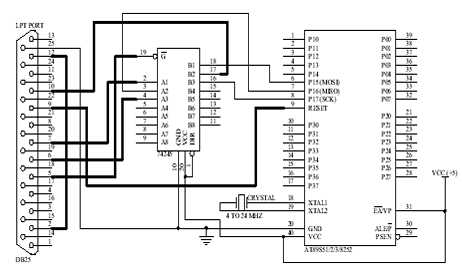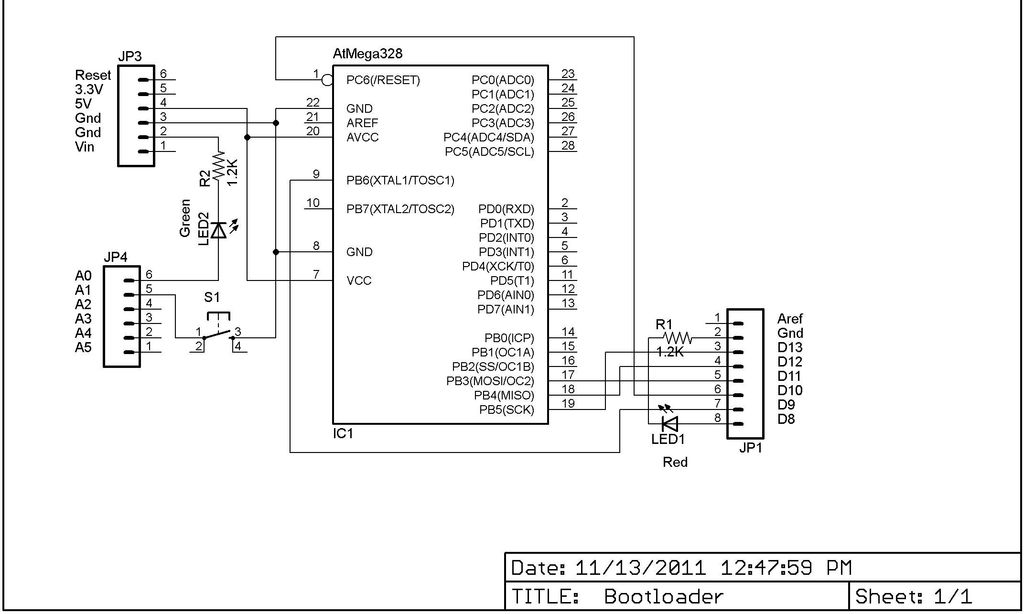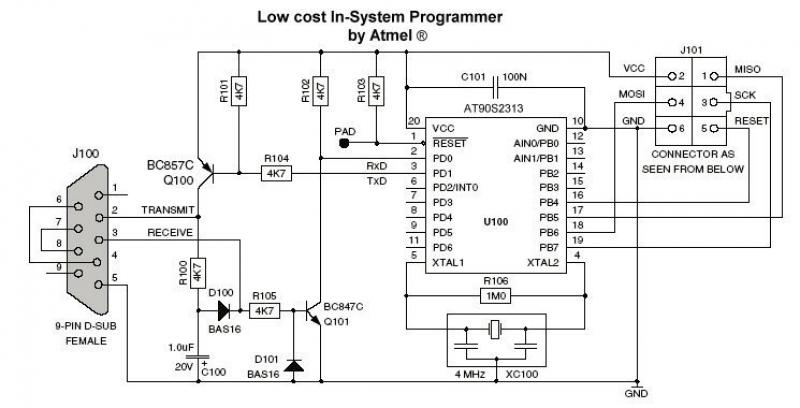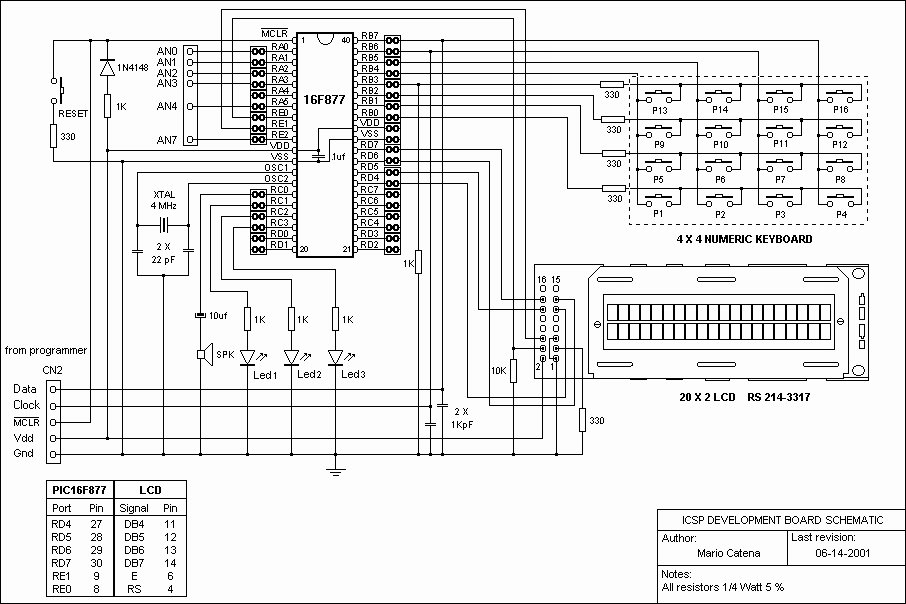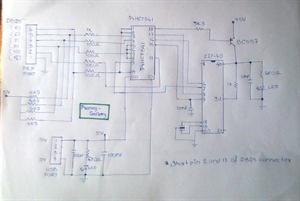
SI Programmer

This circuit allows for the easy programming of AVR microcontrollers including the AT90S1200, AT90S2313 (or ATtiny2313), AT90S8515, and AT90S4414, utilizing the free programming software PonyProg by Claudio Lanconelli. The software can be downloaded for free from the author's website. The SI-Prog is a simplified version of a more complex program designed by Claudio Lanconelli, which supports a wide range of programmable devices. The circuit features an adapter to increase the number of supported AVR microcontrollers. Each pin of the adapter should be connected to the corresponding pins of the microcontroller (e.g., the MISO pin of the adapter to the MISO I/O of the microcontroller) without the need for additional components. It is important to connect a piezoelectric crystal (typically 4, 8, or 10 MHz) to the XTAL pins of the microcontroller; otherwise, the programming process will not succeed. For newer AVR microcontrollers that have an internal crystal, the additional piezoelectric crystal is not required. In such cases, simply connect the adapter to the appropriate pins of the microcontroller to begin programming.
The described circuit serves as a programmer for various AVR microcontrollers, effectively enabling the programming process through a straightforward interface. The SI-Prog circuit is designed to be user-friendly, allowing for easy connections between the microcontroller and the adapter. The adapter plays a crucial role as it extends compatibility to multiple AVR microcontroller models, ensuring that users can program different devices without needing to modify the circuit significantly.
In terms of connections, the adapter must be wired carefully to ensure that each pin aligns correctly with its counterpart on the microcontroller. Precise connections are essential for the successful operation of the programming procedure. The MISO (Master In Slave Out), MOSI (Master Out Slave In), and SCK (Serial Clock) pins must be correctly linked to enable data transfer between the programmer and the microcontroller.
The inclusion of a piezoelectric crystal is critical for timing purposes during the programming process. The specified frequency (4, 8, or 10 MHz) is necessary for the microcontroller to operate correctly, ensuring that the programming signals are processed accurately. In cases where newer AVR microcontrollers are utilized, the internal oscillator can eliminate the need for an external crystal, simplifying the setup process.
Overall, this circuit and its associated software provide a practical solution for programming AVR microcontrollers, catering to both beginners and experienced users in the field of electronics. The ease of use, combined with the flexibility of the adapter, makes this setup a valuable tool for a wide range of applications in embedded systems development.With the following circuit you can easily program the AVR microcontrollers AT90S1200, AT90S2313 (or ATtiny2313), AT90S8515 and AT90S4414, using the freeware programmer PonyProg by Claudio Lanconelli. You can download the program for free from the author`s website ( ). The simple SI-Prog is actually a simplification of the more complicated program mer designed by Claudio Lanconelli, which is supporting a large number of programmable devices. Attention: The circuit includes an adaptor to extend the number of the supported AVR microcontrollers. Simply connect each pin of the adaptor to the appropriate pins of the microcontroller (MISO pin of the adaptor with MISO I/O of the microcontroller, etc) without using additional components.
Remember to connect a piezoelectric crystal (usually 4, 8 or 10MHz) to the XTAL pins of the microcontroller or the programming procedure will fail. Note: With the newer AVR micros that include an internal crystal, you don`t need the additional piezoelectric crystal.
If this is the case, you simply connect the adaptor with the appropriate pins of the microcontroller and you are ready to program! 🔗 External reference
The described circuit serves as a programmer for various AVR microcontrollers, effectively enabling the programming process through a straightforward interface. The SI-Prog circuit is designed to be user-friendly, allowing for easy connections between the microcontroller and the adapter. The adapter plays a crucial role as it extends compatibility to multiple AVR microcontroller models, ensuring that users can program different devices without needing to modify the circuit significantly.
In terms of connections, the adapter must be wired carefully to ensure that each pin aligns correctly with its counterpart on the microcontroller. Precise connections are essential for the successful operation of the programming procedure. The MISO (Master In Slave Out), MOSI (Master Out Slave In), and SCK (Serial Clock) pins must be correctly linked to enable data transfer between the programmer and the microcontroller.
The inclusion of a piezoelectric crystal is critical for timing purposes during the programming process. The specified frequency (4, 8, or 10 MHz) is necessary for the microcontroller to operate correctly, ensuring that the programming signals are processed accurately. In cases where newer AVR microcontrollers are utilized, the internal oscillator can eliminate the need for an external crystal, simplifying the setup process.
Overall, this circuit and its associated software provide a practical solution for programming AVR microcontrollers, catering to both beginners and experienced users in the field of electronics. The ease of use, combined with the flexibility of the adapter, makes this setup a valuable tool for a wide range of applications in embedded systems development.With the following circuit you can easily program the AVR microcontrollers AT90S1200, AT90S2313 (or ATtiny2313), AT90S8515 and AT90S4414, using the freeware programmer PonyProg by Claudio Lanconelli. You can download the program for free from the author`s website ( ). The simple SI-Prog is actually a simplification of the more complicated program mer designed by Claudio Lanconelli, which is supporting a large number of programmable devices. Attention: The circuit includes an adaptor to extend the number of the supported AVR microcontrollers. Simply connect each pin of the adaptor to the appropriate pins of the microcontroller (MISO pin of the adaptor with MISO I/O of the microcontroller, etc) without using additional components.
Remember to connect a piezoelectric crystal (usually 4, 8 or 10MHz) to the XTAL pins of the microcontroller or the programming procedure will fail. Note: With the newer AVR micros that include an internal crystal, you don`t need the additional piezoelectric crystal.
If this is the case, you simply connect the adaptor with the appropriate pins of the microcontroller and you are ready to program! 🔗 External reference
